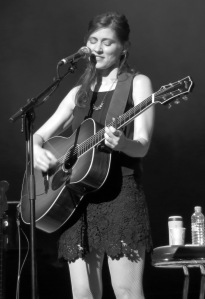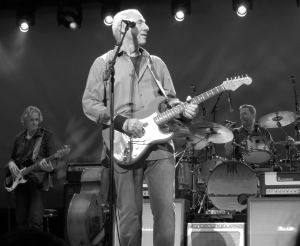There are barely enough superlatives to describe the talents of the great Mark Knopfler. His history with Dire Straits, of course, speaks for itself. His solo career, however, has operated much more under the radar and this way of working has allowed him to record and tour at a much more manageable level than at the height of the success of Dire Straits. Few, if any artists of Mark’s generation are as prolific as he has become over the course of his solo career. He has now produced…now let me think for a moment…a total of nine exquisite studio albums since 1996, all of which are beautifully produced and feature songs which only go to show how perceptive and accomplished a songwriter he is.
Mark has often spoken of how he enjoys the whole cycle of writing, recording, touring and then starting over again and as such, all but one of his solo albums have resulted in a tour. I have been lucky enough to see him and his remarkable band (which has largely remained the same since his first solo tour in 1996) a number of times now, and each show I have seen has been an improvement on the previous tour, even when it seemed impossible that he and the band could possibly get any better. The show at the Royal Albert Hall on Monday 25th May, part of his tour supporting his newest album, Tracker, was no exception.

Before we get onto Mark’s set, I must mention Ruth Moody who was the opening act for this show. Ruth is touring with the band as a guest up to and including Amsterdam, and has been working with Mark since the Privateering album, released in 2012. Make no mistake, she has the most beautiful female singing voice imaginable. Not just beautiful, but profoundly beautiful. Her contributions to the Privateering album were only very subtle, but on Tracker her voice is more obvious and she duets with Mark on the emotional closing track, ‘Wherever I Go’. Quite apart from being a sublime vocalist, she is a multi-instrumentalist and a formidable songwriter. Her two solo albums, The Garden and These Wilder Things, are highly recommended. A word of warning though – the merest suggestion of her voice may well cause your eyes to water, so please do not listen to her whilst driving!
Ruth’s set at the Albert Hall consisted of a number of songs from These Wilder Things amongst others with her wonderful four-piece band, and demonstrated not only how beautiful her voice is but also how incredibly accurate a vocalist she is. She simply doesn’t put a foot wrong. Every note is delivered with absolute perfection. I feel extremely fortunate to have had the chance to see Ruth live and I can safely say she has a new committed fan right here.
On to Mark’s set. He opened with a new song from the Tracker album called ‘Broken Bones’. This is a very classy, funky little number and the band entered the stage encouraging the audience to clap along, which they duly did with the minimum of fuss. Mark then came on, only playing a simple rhythm part on this song and leaving the lead in the capable hands of his long-time band mate Richard Bennett. Excellent performances of ‘Corned Beef City’ and ‘Privateering’ came next, and were followed by the instrumental ‘Father and Son’ from 1984’s Cal soundtrack, which segued into ‘Hill Farmer’s Blues’, from 2002’s The Ragpicker’s Dream. The power and energy of the live version of this song, as well as Mark’s guitar solo outro, have never failed to impress.
One of my personal highlights of the evening was the performance of ‘Skydiver’, a new song from Tracker which featured backing vocals from Ruth Moody. Much of the texture of the chorus of this song comes from the layers of vocal harmonies over the top of a descending chord progression. Mark’s voice was perfect here and demonstrated how far he has come as a vocalist in recent years. A drum solo from the impressive Ian Thomas then led into another new song, ’Laughs and Jokes and Drinks and Smokes’, featuring Mark’s gorgeous blue Pensa MK D guitar. His vocal on this was strong once again.
As well as Ruth, saxophonist Nigel Hitchcock is guesting with the band until Amsterdam and his remarkable abilities were utilised on the rock ’n’ roll infused ’I Used to Could’. Keyboardist Jim Cox also impressed on this song, as did Mark on lead guitar. This song was particularly well received and showed just how strong the musical chemistry is between the members of this band.
Then followed the first of a handful of Dire Straits classics of the night, ‘Romeo & Juliet’. Once again, Nigel Hitchcock featured on this song and, as was the case when I previously saw the band live at Bournemouth in 2013, the tone he gets out of the saxophone on these more emotive songs is beautifully clear and a joy to listen to. As is now traditional at a Mark Knopfler show, ‘Romeo & Juliet’ was followed immediately by ‘Sultans of Swing’, which resulted in a well-deserved standing ovation.
The next song, another new one called ‘Mighty Man’, for me, was one of the surprises of this show as I had not thought of it as a song that would work well in a live context, due to its slow and relatively sparse nature. In fact, it worked extremely well and featured possibly the best vocal performance of the night from Mark, as well as some excellent slide guitar on his white 1964 Stratocaster. ‘Postcards from Paraguay’, as on the previous tour, was used to introduce each band member in turn during the intro, with each member joining in as they were announced.
Leading towards the encores, ‘Marbletown’, which has been a set regular for some years now, is the ultimate example of how well this band gels. The chemistry between all of them is almost on a telepathic level throughout the extended outro and is a showcase particularly for the skills of John McCusker on fiddle, Mike McGoldrick on whistle and Glenn Worf on upright bass. ‘Speedway at Nazareth’ was as powerful as ever and once again a demonstration of how well this band works as a unit. ‘Telegraph Road’, featuring an outstanding performance by Mark during the guitar solo outro resulted in another standing ovation.
In the encores, the impossibly catchy ’So Far Away’ got the entire audience singing along, and Mark could probably have done with a little help on this song as his voice seemed to get a little lost in the mix here, but it was a superb performance nonetheless with smiles all round on stage at the end of the song. Ruth then returned for the duet on the wonderful ‘Wherever I Go’ – perhaps the most emotional moment of the evening. Mark and Nigel’s duelling guitar and saxophone solo at the end of this song was sublime. The show ended with a triumphant rendition of ‘Going Home’, from the Local Hero soundtrack.
As I have eluded to above, the chemistry between the members of this band is something very special. They consistently better themselves with each tour, and Mark continues to write wonderful new material to add to the set each time. Indeed, the set is now dominated by solo material, and yet the audiences seem to react just as well to the shows as they would if they consisted entirely of Dire Straits songs. This only goes to show that you don’t have to roll out all the hits to maintain the interest of the audience. If you have good songs and the band enjoy playing them, that enjoyment will translate to the audience.

Seeing a Mark Knopfler show in person is a special experience and you would honestly be hard-pressed to see a better live band than his anywhere, at any time. Always looking ahead to the next album or the next tour, clearly he enjoys both recording and touring immensely, and one would hope that he will continue doing so for some years to come, because there does not seem to be anybody else out there who can even compare with him.
Don’t forget to check out Mark’s multi-instrumentalist extraordinaire and co-producer Guy Fletcher’s tour diary at http://www.guyfletcher.co.uk, and also his guitarist Richard Bennett’s ‘Notes from the Road’ at http://www.richard-bennett.com.
